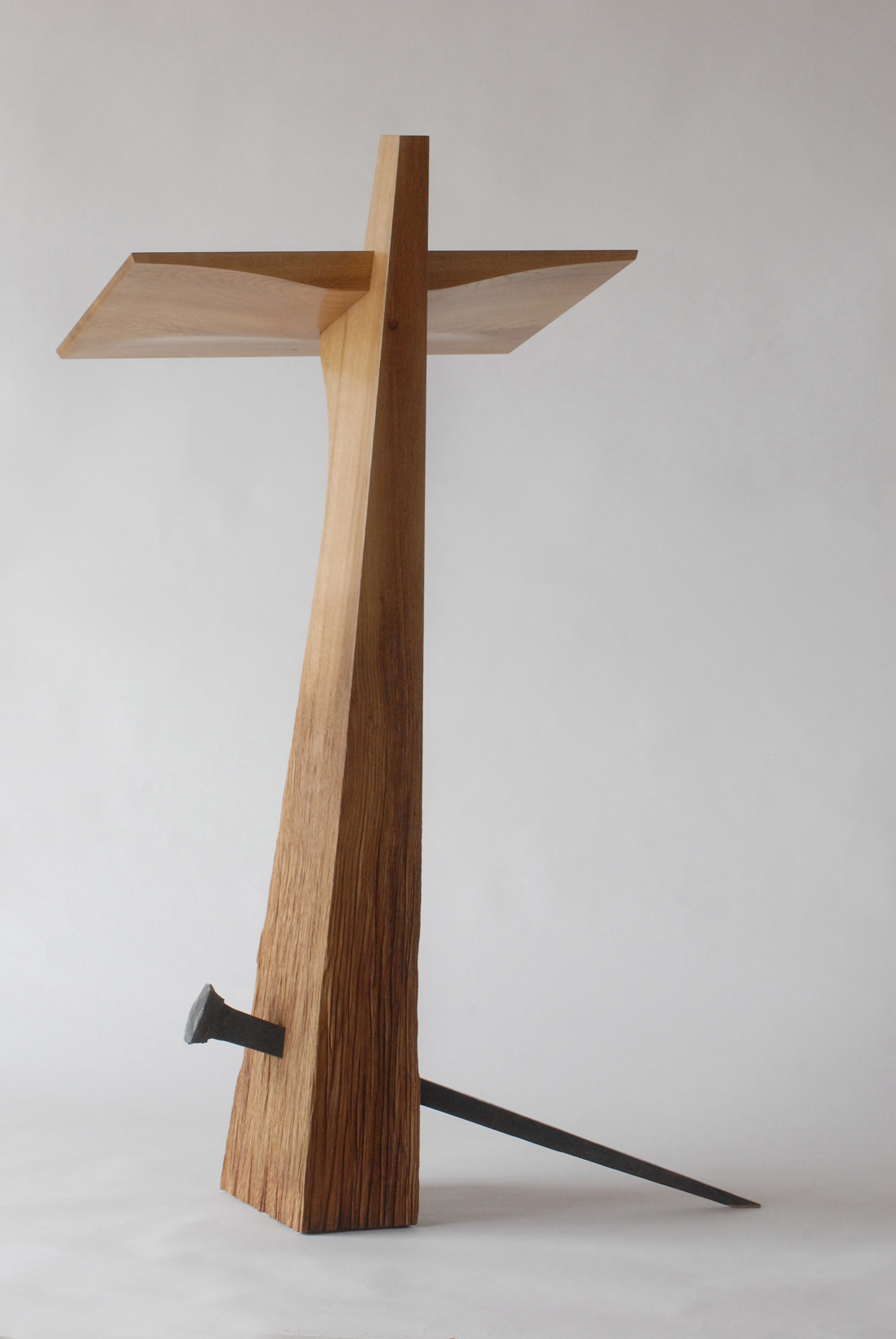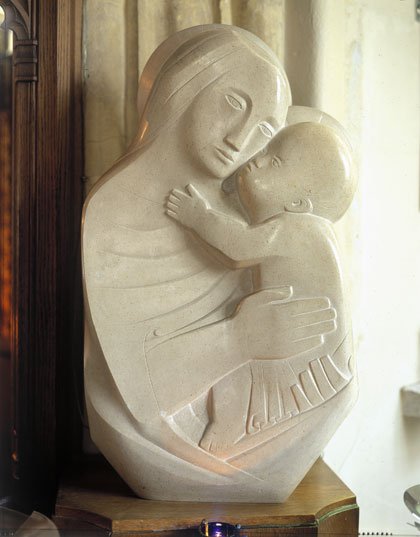William Mitchell: Stations of the Cross
The architectural sculptor William Mitchell was commissioned to make the Stations of the Cross for the new Clifton Cathedral, built 1969–73 to designs by Ronald Weeks in close collaboration with clergy and theological advisors. The concrete church, almost entirely monochrome and undecorated, is notable for the success of its integration of the ideas of the liturgical reform movements of the twentieth century, and its expression of the principles of the Second Vatican Council – a ‘sermon in concrete’, in the words of Nikolaus Pevsner.
Elisabeth Frink: Eagle (lectern)
Elisabeth Frink’s bronze lectern for Basil Spence’s Coventry Cathedral was her first major commission. She was known at the time for her sculptures and drawings of birds – one made while she was a student was exhibited in 1952 and bought immediately by the Tate Gallery – and the lectern was to take the traditional form of an eagle.
Julian Phelps Allan: Baptistry relief
Sutton Baptist Church was the architect N. F. Cachemaille-Day’s only known non-conformist commission; with its imposing, fortress-like brick exterior and spacious interior it is referred to informally as the ‘Baptist Cathedral’. The interior echoes the churches of German Expressionism with full height pointed arches. The architectural and liturgical centre of the church is the baptistery, against the east wall, with a pool of Hopton Wood stone and a brick reredos under a large window by Christopher Webb of scenes from Pilgrim’s Progress. Presiding over the pool, framed by two dramatic twisted brick columns, is Julian Phelps Allan’s sculpted relief depicting the Baptism of the Ethiopian.
Victoria Rance: Comforter
St Laurence Church, Catford, is a notable octagonal church built by Ralph Covell in 1968. The east wall behind the freestanding altar presented a problem that for several decades remained unsolved. A plain cloth screen covering the organ pipes formed an unsatisfactory backdrop to the sanctuary, despite an illuminated dalles de verre cross in its centre. The space ‘was an empty vacuum – not even a positive absence – a negative space demanding to be filled’, as Charles Pickstone, the current vicar, has put it. Victoria Rance, an artist based in nearby Deptford, was commissioned in 2008 to produce a work that would solve this problem, with enough visual force to fill and unite the space without distracting from the altar and sanctuary.
Harry Stammers: Majestas
The original chapel of St Michael’s theological college was destroyed by bombing, and the architect George Pace was commissioned to design a replacement.
Kate Egawa: Black Madonna and Child of Covid-19 Lockdown
The project for the ‘Black Madonna and Child of Covid-19 Lockdown’ (Our Lady of Kilburn) arose from the community’s experience during COVID lockdown. St Mary’s is a Black majority congregation, with most being women of working age. Many were aware of significant racial and gender differences in the effects COVID had.
Antony Gormley: Transport
‘Antony Gormley’s Transport in Canterbury is a large and striking human figure, created from iron nails formerly in the roof of the Cathedral. It is suspended three metres above the floor of the site of the first burial place of St Thomas Becket in the Eastern Crypt. [...] This is a beautifully made and very clever piece of work which impresses by its technical accomplishment’ (The Very Revd Nicholas Frayling, Chair of the judging panel for the ACE Award for Art in a Religious Context, 2011).
Charles Jagger: The Kelham Rood (Christ, The Blessed Virgin Mary and St John)
Originally sculpted for the chapel at Kelham Hall in Nottinghamshire, and commissioned by the Society of the Sacred Mission, the Rood now sits in the south nave of St John the Divine where the SSM was founded in the 19th Century.
Stephen Owen: Communion table and lectern
Winner of the A+C Art Award for a permanent commission, Stephen Owen’s carved communion table and lectern are powerful symbolic pieces of liturgical furniture.
Laurence Edwards: Beast of Burden
Behind the altar table in Holy Trinity Church in Blythburgh, Suffolk, is a powerful altarpiece by Laurence Edwards. Cast in bronze from the mud, wood and hogweed that can be found all around the Suffolk locality, Edward’s sculpture brings the precise beauty of the outside marsh into the church in a way that combines imagination, emotion and spirit.
Antony Gormley: Sound II
Who are we and where do we come from? These are the questions we are born asking, and they prompt answers we go on questioning. There we stand, hearing the sound of our own questions and the sound of our own answers, yet never satisfied, never finished with the task … there we stand, pondering the sound we make, longing for silence …
Giacomo Manzù: St Thérèse of Lisieux
In response to the invitation by the Westminster Cathedral Art and Architecture Committee to Giacomo Manzu that he should produce a low relief bronze wall panel showing St Thérèse of Lisieux for the Cathedral, Manzu submitted a sketch in 1956. This was immediately approved and the commission awarded. Manzu then proceeded to design and produce the bronze in Italy with casting taking place in Milan.
Nicholas Mynheer: Resurrection Altar
The altar that stands solidly as the ‘centre-point’ in the Resurrection Chapel around which the Community of the Resurrection and its guests gather on most days for the celebration of the Eucharist was designed and sculpted by Nicholas Mynheer.
Angela Conner: Reredos sculpture
This striking sculpture gives a dynamic focus to the church which takes a simple tent-like form. Behind the austere altar table the outstretched arms of the reflected figure invoke a well-proportioned ellipsis on the east wall.
Henry Moore: Madonna and Child
Henry Moore’s Madonna and Child is a work of international significance. The sculpture is in Hornton stone and was carved for the church by Moore in 1943-44.
Emily Young: Lunar Disc I
The large onyx disc was installed as a gift on the north west lawn in the Close of Salisbury Cathedral but has since been transported elsewhere. It is made of one billion year old, semi translucent onyx and is around two metres tall.
Geoffrey Clarke: High Altar cross
Made from silver and plated with gold, this abstract work represents a phoenix rising from the ashes.
Susanna Heron: Still Point
Still Point is a meditative spatial work incorporated into the cathedral grounds. It has three associated parts: a stone element, a poem and a song.
Barbara Hepworth: Madonna and Child
Barbara Hepworth’s Madonna and Child was carved in memory of her son Paul who died in an RAF plane crash over Thailand in 1953.
Ecclesiart is an online project that raises awareness of significant works of modern and contemporary art since 1920 in UK churches and cathedrals.
The selected works represent the diversity of high quality church commissions and reflect developments in artistic practice and ecclesiastical art and design. You can explore the collection using the tiles below or by using the Ecclesiart map.
We seek to encourage increased responsibility towards works which may be under-appreciated or at risk and hope that this selection of works provides inspiring and challenging examples of art in churches useful to any parish or individual wishing to commission a new work.
We welcome nominations of new works to be added to Ecclesiart. Please email us with a short text about why you think a work of art should be included with a short theological reflection on the work and its context (no longer than 150 words) and if possible please include images. Please note that we do not accept nominations from artists for their own work.
All permanent works shortlisted for the Award for Art in a Religious Context are added to Ecclesiart. For all other nominations, the Director and trustees of Art and Christianity reserve the right to select works which they determine as meeting the criteria of aptness to context, artistic and technical merit and appropriate theological meaning.




















